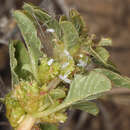Comments
provided by eFloras
Two varieties have been distinguished by J. Henrickson (1999) within Amaranthus crassipes: var. crassipes with leaf blades nearly orbiculate to ovate (obovate) and conspicuous veins on the green to yellow-green abaxial leaf surface; and var. warnockii (I. M. Johnston) Henrickson (= A. warnockii I. M. Johnston) with narrower oblanceolate grayish leaves with less distinct venation on the abaxial leaf surfaces. In Henrickson’s treatment, var. crassipes occurs mostly in the coastal areas (and is also reported for Arizona), while var. warnockii is reported from inland southwestern Texas and the Chihuahuan Desert region (Mexico: Coahuila, Chihuahua). We have not seen material of the new varieties and cannot evaluate their validity.
- license
- cc-by-nc-sa-3.0
- copyright
- Missouri Botanical Garden, 4344 Shaw Boulevard, St. Louis, MO, 63110 USA
Description
provided by eFloras
Plants annual, glabrous. Stems prostrate or weakly ascending, erect when young, branched mostly from base, 0.1-0.6 m. Leaves: petiole nearly 1/2 as long as blade; blade broadly elliptic, obovate, orbiculate, or oblanceolate, (0.5-)1-3(-4.5) × 0.3-2(-2.5) cm, base cuneate, margins entire, plane to undulate, apex broadly rounded or emarginate. Inflorescences axillary clusters borne from base to apex, axes much thickened, appearing inflated, becoming indurate at maturity (only in A. scleropoides and A. crassipes). Bracts of pistillate flowers keeled (only A. scleropoides and A. crassipes have keeled bracts), deltate, 0.5-0.9 mm. Pistillate flowers: tepals (4-)5, narrowly spatulate, clawed, with small expanded blade, equal or subequal, 2-3 mm, apex rounded and apiculate; claws becoming indurate and scarious at maturity; style branches spreading; stigmas usually 2(-3), almost sessile. Staminate flowers intermixed with pistillate; tepals 5, membranaceous; stamens 3(-5). Utricles obovoid to compressed-obovoid, 1.4-2 mm, shorter than tepals, prominently muricate (especially in distal 1/2), indehiscent. Seeds dark brownish or reddish black to black, compressed-ovoid to broadly lenticular, 1-1.4 mm diam., shiny.
- license
- cc-by-nc-sa-3.0
- copyright
- Missouri Botanical Garden, 4344 Shaw Boulevard, St. Louis, MO, 63110 USA
Distribution
provided by eFloras
Ala., Ariz., Fla., La., N.Mex., S.C., Tex.; ne Mexico; West Indies; n South America; occasionally introduced in other regions.
- license
- cc-by-nc-sa-3.0
- copyright
- Missouri Botanical Garden, 4344 Shaw Boulevard, St. Louis, MO, 63110 USA
Flowering/Fruiting
provided by eFloras
Flowering summer and fall.
- license
- cc-by-nc-sa-3.0
- copyright
- Missouri Botanical Garden, 4344 Shaw Boulevard, St. Louis, MO, 63110 USA
Habitat
provided by eFloras
Open, seasonally wet flats, shores of water bodies, waste places, other disturbed habitats; 0-1300m.
- license
- cc-by-nc-sa-3.0
- copyright
- Missouri Botanical Garden, 4344 Shaw Boulevard, St. Louis, MO, 63110 USA
Synonym
provided by eFloras
Amaranthus crassipes var. warnockii (I. M. Johnston) Henrickson; A. warnockii I. M. Johnston
- license
- cc-by-nc-sa-3.0
- copyright
- Missouri Botanical Garden, 4344 Shaw Boulevard, St. Louis, MO, 63110 USA
Comprehensive Description
provided by North American Flora
Amaranthus crassipes Schlecht. Linnaea 6: 757. 1831
Scleropus amar anthoides Schrad. Ind. Sem. Hort. Gotting. 1835; Linnaea 11: Litt.-ber. 89. 1837. Sderopus crassipes Moq. in DC. Prodr. 13 2 :' 271. 1849. Euxolus crassipes Hieron. Bol. Acad. Nac. C6rdoba 4: 13. 1881.
Stems ascending or prostrate, 2-6 dm. long, stout, succulent, glabrous; petioles slender, 3-40 mm. long; leafblades deep-green, oblong to spatulate, ovate, or obovate, 0.5-3.8 cm. long, 0.5-2.5 cm. wide, rounded and shallowly emarginate at the apex, decurrent at the base, glabrous, thick, with prominent white veins; flowers monoecious, in small dense axillary clusters; peduncles thickened and indurate; bracts small and inconspicuous, indurate in age, ovate, acutish, green, with scarious margins; sepals of the pistillate flowers 4 or 5, 1.5 mm. long, scarious, spatulate, obtuse, often emarginate; style-branches 2, stout; utricle obovoid, compressed, coriaceous, finely tuberculate, indehiscent; seed about 1 mm. in diameter, smooth, dark-brown or black.
Type locality : Island of St. Croix.
Distribution: Waste ground, peninsular Florida, Bahamas, and the West Indies; adventive at Mobile, Alabama; also in Venezuela and Colombia.
- bibliographic citation
- Paul Carpenter Standley. 1917. (CHENOPODIALES); AMARANTHACEAE. North American flora. vol 21(2). New York Botanical Garden, New York, NY
Amaranthus crassipes
provided by wikipedia EN
Amaranthus crassipes, also known as spreading amaranth, is a glabrous annual plant that is both native and introduced in the United States. In the U.S., it is found in New Mexico, Arizona, Texas, Alabama, South Carolina, and Louisiana. It is also found in Mexico, the West Indies, and South America.[2]
The plant can grow up to two feet in height. It flowers in the summer and fall. It is usually found near wet habitats or disturbed areas.
Two varieties of A. crassipes have been described: A. crassipes var. crassipes and A. crassipes var. warnockii.[3] The major difference appears to be the leaf structure.
References

- license
- cc-by-sa-3.0
- copyright
- Wikipedia authors and editors
Amaranthus crassipes: Brief Summary
provided by wikipedia EN
Amaranthus crassipes, also known as spreading amaranth, is a glabrous annual plant that is both native and introduced in the United States. In the U.S., it is found in New Mexico, Arizona, Texas, Alabama, South Carolina, and Louisiana. It is also found in Mexico, the West Indies, and South America.
The plant can grow up to two feet in height. It flowers in the summer and fall. It is usually found near wet habitats or disturbed areas.
Two varieties of A. crassipes have been described: A. crassipes var. crassipes and A. crassipes var. warnockii. The major difference appears to be the leaf structure.
- license
- cc-by-sa-3.0
- copyright
- Wikipedia authors and editors

